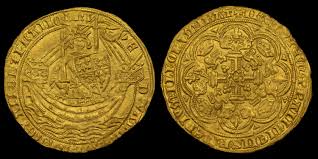As the Hundred Years’ War (1337–1453 CE) dragged on, the cost of warfare continued to rise. England, under King Edward III, needed a stable and valuable currency to finance its military campaigns, pay mercenaries, and support international trade. In 1344 CE, Edward III introduced the gold noble, England’s first major gold coin in over 500 years. The gold noble became a crucial tool in England’s war economy, strengthening its financial position both domestically and abroad.

Why Did England Introduce the Gold Noble?
1. War Expenses & Mercenary Payments
- England needed a reliable, high-value currency to pay professional soldiers and foreign mercenaries, many of whom preferred to be paid in gold rather than silver.
2. Strengthening England’s Economy & Trade
- The introduction of the gold noble stabilized England’s monetary system, making it easier to conduct large financial transactions.
- It boosted England’s wool trade, as merchants could now use a stable gold coin for exports.
3. Competing with Foreign Gold Coins
- By the 14th century, many European states had already issued gold currencies (e.g., the Florentine florin and Venetian ducat).
- England needed its own gold coin to maintain economic and political influence.
Features of the Gold Noble (1344 CE)
The gold noble was carefully designed to be widely accepted and trusted:
✅ Weight & Purity – Weighed 7.8 grams of gold, with a high purity.
✅ Design – Featured King Edward III standing in a warship, symbolizing England’s naval strength.
✅ Value – Initially worth 6 shillings and 8 pence, making it suitable for large transactions and military financing.
The noble was so well-regarded that it remained in circulation for over a century, influencing later English gold coins like the angel and the sovereign.
The Impact of the Gold Noble on England’s War Effort
The gold noble played a direct role in funding England’s military during the Hundred Years’ War:
- Used for war loans – English kings secured gold-backed loans from Italian and Flemish bankers.
- Paid to mercenaries – Foreign soldiers preferred gold nobles over silver currency.
- Strengthened England’s financial independence – Reduced reliance on foreign gold coins, giving England more control over its economy.
With the gold noble, England established a stable gold currency, reinforcing its position in European trade and war finance.
Conclusion: The Gold Noble as a Game Changer
The introduction of the gold noble in 1344 CE marked a turning point in England’s economic history. It:
✅ Helped finance the Hundred Years’ War, supporting England’s military campaigns.
✅ Boosted international trade, making England a stronger player in European commerce.
✅ Established England’s tradition of gold coinage, paving the way for later gold coins like the angel and sovereign.
The noble solidified gold’s role in medieval warfare and finance, proving that control over gold reserves and coinage was just as important as battlefield victories.
